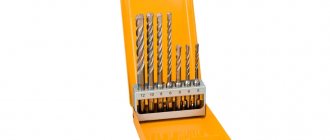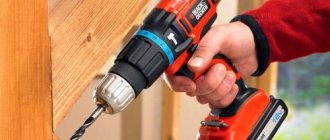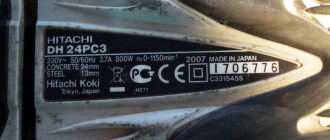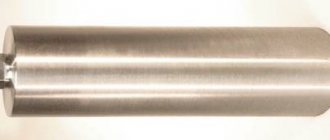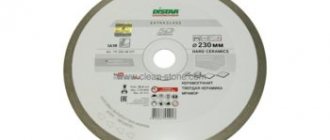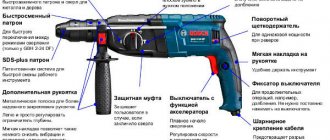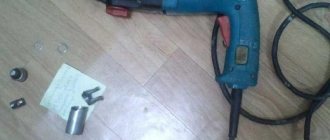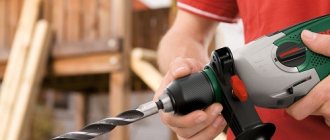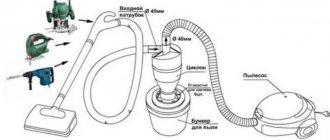A concrete hammer drill is a metal tool that can be successfully used for drilling holes in structures also made of brick, natural and artificial stone. Concrete drills are used in construction and repair work and are classified according to various parameters: design, power of the equipment on which they are installed, type of shank, as well as the geometric parameters of their spiral part.
The right drill can be selected for each specific task
Important parameters
Without drilling holes in various surfaces, construction and repairs are impossible. And if a regular electric drill is quite suitable for making holes in a structure made of wood materials, brick and plasterboard, then only a hammer drill can cope with a concrete structure. The peculiarity of this equipment is that it can not only drill the surface being processed, but also exert an impact load on it, that is, perform the function of a jackhammer. Naturally, to install it on a hammer drill you need to use a special tool - a drill. It differs from a conventional metal drill in a number of parameters.
The drills differ from each other in their design features, among which the following should be highlighted:
- design of the spiral part;
- the presence of a special cavity in the inner part;
- material for manufacturing the working part, which can be a hard alloy;
- number and geometric parameters of cutting edges.
Main parts of the drill
Drills are also distinguished from ordinary drills by the design of the shank, which allows them to be securely fixed in the chuck of the equipment used. The most common types of concrete drill shanks and chucks used when working with rotary hammers are the following.
SDS+
SDS-plus drills, like cartridges in this category, are designed for installation on medium and light series rotary hammers. It is devices of this type that are most often used by home craftsmen to perform various repair and construction work. The diameter of the SDS-plus shank cannot exceed 18 mm.
Drills with this shank are designed for light construction hammer drills
SDS-max.
Drills with shanks of the SDS-max category (the diameter of their fastening part exceeds 18 mm) are intended for concrete processing. Drills with shanks of the SDS-max category (the diameter of their fastening part exceeds 18 mm) are used in the configuration of rotary hammers of the professional series.
The SDS-max system with an increased contact area of the wedges is designed for heavy hammer drills
The main manufacturers of SDS-plus concrete drills (the most popular category) are Chinese companies. As a rule, the parameters of such products comply with the requirements set by GOST, so they can be installed on any rotary hammers. Meanwhile, you should not try to insert a tool for working with concrete into a regular drill, since it will not be possible to do this even with considerable effort.
To choose the right drill for a hammer drill, you should take into account such parameters of the working part as:
- length, the size of which determines how deep the hole you can drill;
- diameter.
Operating parameters of the drill
Taking into account the fact that hammer drills are used to work with particularly durable materials (concrete, natural and artificial stone), their design has a reinforced design, and the working part is made in the form of a double spiral. This is what allows you to use hammer drills when working with concrete and other materials for a long time, without worrying about their technical condition. Many models of concrete drills for rotary hammers are equipped with a tip made of the strongest alloy of the VK8 brand, which allows them to be successfully used for processing materials of particularly high strength.
Selecting tools of this type is not difficult: all of their most significant parameters are indicated in the labeling. For example, if in front of you is a concrete drill marked 6x160, this means that it has the following dimensions: working diameter - 6 mm, length - 160 mm. It must be borne in mind that the marking of the tool indicates its working length, which is slightly smaller than the dimensions of the working part.
The diameter of the working part of concrete drills installed on a hammer drill can be in the range of 4–30 mm. The most popular sizes fall in the range of 6–10 mm. Using a concrete drill of this size, you can, in particular, make a hole for placing a dowel.
How to choose the right drill
The choice of drill to equip a hammer drill should take into account the strength of the material in which the hole needs to be made. The degree of steepness of the spiral part is also of great importance: the larger it is, the deeper the hole can be drilled at a higher speed. When using a tool with such characteristics, waste material is more efficiently removed from the processing area, which allows you to work very quickly.
How to choose a drill for concrete? It is advisable to rely on the advice of specialists with experience in construction and repair work.
- For drilling shallow holes in concrete, a tool with a flatter spiral is suitable, which is also stronger and more durable.
- It is always better to choose tools from trusted manufacturers, since products from little-known brands are not always of decent quality and may not be suitable for hammer drill cartridges.
Concrete structures are drilled with a perforator, not drilled. The main requirement for a drilling tool is reliability
When purchasing a drill for a hammer drill, you should take into account not only GOST, but also the price category of the tool. On the modern market, you can choose both expensive drills for professional use and cheap disposable ones that do a good job with the tasks. High quality at an affordable price for concrete drills produced under the Bosch, Sturm and Makita brands.
Depending on their purpose, drills for rotary hammers are divided into several categories.
Auger
These tools, ideal for drilling holes of considerable depth with a hammer drill, due to their design features, create a minimal amount of dust during operation and do not place a large load on the hammer drill.
Auger drill with carbide inserts
With a significant inclination of the working groove
The use of tools of this type allows drilling at high speed, which significantly increases the productivity of this process. When deciding to choose a drill for a hammer drill of the specified type, you should keep in mind that such a tool creates a significantly greater load on the equipment used than an auger one.
With a slight inclination of the working groove
Tools of this type, provided they are used with light loads, have an increased service life.
Crowns
These tools are used to create large diameter holes in concrete. This can be either a diamond drill or a drill, the working part of which is equipped with cutting plates made of hard alloy.
Drill bit with carbide cutters
It is recommended to apply lubricant to the shanks of drills installed in a hammer drill, then the tool will last much longer and its use will be more efficient.
Drills installed on a hammer drill for concrete processing are divided into two main types:
- breaking (needed to make large diameter holes in concrete);
- walk-through (they have great power and allow you to make holes even in load-bearing concrete walls of building structures).
Heads of through-and-break drills provide precise punching due to the centering rod and rapid advancement due to chisel-shaped cutters
How to choose a rotary hammer?
The main cutting tool is selected in accordance with the fastening system provided in each specific hammer drill. The most common is SDS+.
To determine the necessary device, you need to answer a number of questions:
- Types of work performed – what diameter and how deep the holes need to be drilled:
- for a large number of holes with small dimensions, it is advisable to opt for a drill with a small inclination of the grooves;
- It is more convenient to make deep holes with drills with screw-inclined grooves;
- The intensity of use of a tool affects its strength and service life. A drill on which the rod has several spiral grooves to remove drilling products will help reduce the load.
- Material to be processed - for concrete you should choose a more durable drill, with carbide tipping, than for brick products. With a large volume of operations, you can consider the option of semi-professional products with cross-shaped soldering made of carbide steels.
Criterias of choice
Few doubt that a good tool is the key to successful work.
Here are several criteria by which you can determine the quality of a product with sufficient accuracy:
- Appearance of the packaging - a good product will not be sold in bulk; it must be placed in individual packaging;
- The packaging must indicate the main parameters of the tool , the date and place of production, and the manufacturer’s trademark;
- The name, brand of the manufacturer - a company that values its reputation will not supply low-quality products to the market.
Additionally, you need to pay attention to the appearance of the drill itself.
Quality products have:
- Flat, smooth surface.
- There are no irregularities, scuffs, or burrs on the surface of the product.
- The carbide bit must be located exactly in the middle, relative to the axis of the drill.
- The spiral groove is made with smooth, even contours.
Drills and drills: differences
The main difference between a drill and a conventional drill is the design of the shank, which has a special groove. It is precisely because of the presence of such a groove that the drill cannot be inserted into the chuck of an electric drill. In addition, the distinctive features of the drills include:
- increased rigidity, which makes it possible to successfully drill even very durable materials;
- high productivity, which is achieved due to the fact that drilling is carried out with the simultaneous application of a shock load to the material being processed.
A shank with certain grooves is the visible and main difference between hammer drill bits and drill bits
To reliably fix the concrete drill in the hammer drill chuck, as well as to quickly replace it with the selected tool, the SDS fastening system (SDS), developed by Bosch specialists, is used.
Depending on the category of the hammer drill and the type of drill used, a fastening system of one of five types can be used to fix the latter.
SDS
This system is used to hold tools with a shank diameter of 10 mm (this shank has two grooves).
SDS-plus
This is the most popular category of fastening devices, also used to secure tools with a shank diameter of 10 mm in a hammer drill. The SDS-plus shank has not two, but four grooves, two of which are closed.
SDS-top
This is a not very common category of fastening systems used to secure tools whose shank has a diameter of 14 mm. Devices of this type are used to complete rotary hammers of medium weight category.
SDS-max
Such devices are used to complete powerful rotary hammers of the professional series. They are equipped with drills with a shank diameter of 18 mm.
SDS-quick
This not very common category of fastening systems is notable for the fact that on the shank of the tools for which it is intended to secure, there are not grooves, but protrusions.
This type of shank was used in Bosch Uneo rotary hammers
When deciding which drills are best for equipping a rotary hammer, you must first focus on the tasks that you are going to solve. According to this, you can choose a drill:
- for drilling holes of small diameter (its cutting edges are slightly rounded, which makes it possible to give it higher strength);
- crown type, with the help of which large-diameter holes are created (for example, a diamond drill).
Adapters are used to install a drill with a non-native shank into a hammer drill.
SDS-plus
The most common type of shanks. The shank diameter is 10 mm and it also fits into a 40 mm chuck. Unlike SDS, it has not two, but four grooves - two open and two closed. Open grooves are intended for guides, and closed ones are for fixing (locking) balls. In this case, the contact area of the shank with the chuck wedges is 75 square meters. mm. The main tool for drills with SDS-plus shanks are lightweight construction hammers. At the same time, the length of the drills ranges from 110 to 1000 millimeters, and the diameter from 4 to 26 millimeters.
Drill design features
What is the design of any concrete drill used to complete a hammer drill?
Shank
Using this structural element, the tool is fixed in the hammer drill chuck. Depending on the category of the fastening system, as mentioned above, drill shanks may have significant design differences.
Body
This structural part bears the main load. To ensure high reliability of the drill body, especially strong grades of steel are used for its manufacture.
Cutting part
This element does the main job of drilling holes. Depending on the purpose of the tool, its cutting part may have a different design and be made of different materials. Cutting parts are produced with diamond coating (diamond drill), as well as from carbide plates.
Diamond bit set for rotary hammer
Tool dimensions
To choose the right drill for a hammer drill, you should focus on three main parameters: the diameters of the shank and working part, and the working length. All sizes of drills are specified by the corresponding GOST, which greatly simplifies the choice.
When purchasing a tool of a certain diameter for a hammer drill, you can rely on the following recommendations.
- To perform housework, as a rule, drills with a diameter of 6, 8 and 10 mm are used.
- To drill holes for fastening massive and heavy objects, drills with a diameter of 10 and 20 mm are used.
Categories of concrete drills
Drills for concrete hammer drills, the dimensions of which are also regulated by GOST, consist of:
- spiral-shaped rod;
- cutting part;
- shank.
Drills for concrete work can be divided into three main categories:
- self-sharpening (specially designed for drilling deep holes with a hammer drill; when used, broken and crumbled concrete is well removed from the hole);
- spiral (highly efficient when dismantling massive concrete structures);
- with a flat arrangement of the spiral part (such drills, which require significant effort during use, are used for drilling shallow holes).
Concrete drill for professional use with double helix
You should also highlight a diamond drill, with which you can drill concrete structures reinforced with metal reinforcement. A diamond drill can significantly increase the productivity of work performed, but it must be taken into account that the cost of diamond drills for concrete is quite high.
There are also special types of drills, the requirements for the parameters of which are also specified by the corresponding GOST. These include, in particular:
- crowns;
- chisels;
- channel drills;
- flat chisels.
Dimensions of drill bits for concrete hammer drills
A concrete hammer drill has two characteristics: diameter and length. Small-diameter drills are not long, and similarly, it is very rare to come across thick and short drills at the same time. There are a lot of drills of different sizes and diameters. Most of them are presented in the following tables:
SDS Plus sizes
SDS Max Dimensions
In addition, there are drills of intermediate sizes. For example, a drill with a diameter of 6.5 is needed specifically for self-tapping screws for concrete, the so-called dowels.

